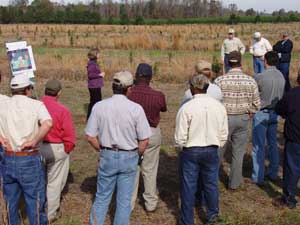Last November, the Mississippi Grazing Lands Conservation Initiative, Natural Resources Conservation Service and Jeff Davis Soil and Water Conservation District sponsored a Silvopasture Field Day at the Larry Rogers Farm in Prentis, Mississippi. Larry has installed a silvopasture demonstration area on his farm which was funded by the National Agroforestry Center (NAC). They have done an excellent job with the establishment of both the longleaf pine and loblolly pine silvopasture systems. These systems will serve as an excellent comparison of the two species used in similar systems as they develop through the years.
Dr. Terry Clason and Jim Robinson, NRCS foresters, provided an overview of silvopasture to the 100 to 120 participants at the field day before the tour stops actually started. There were three stops on the tour where the silvopasture systems were established.
 |
Debby Carnathan, District Conservationist, discusses using the EQIP program for installing silvopasture systems during the workshop at Houston, MS (Photo courtesy J. Robinson) |
Stop one covered silvopasture establishment, and was presented by John Polk and Andy Londo from Mississippi Forestry Association and Mississippi State University Extension Service.
Stop 2 was on forage production and management and was presented by Richard Watson, MSU Forage/ Grassland Specialist and Walter Jackson, NRCS, State Grass Land Specialist.
Stop 3 was the tree management stop and was presented by NRCS foresters Alan Holditch, Jim Robinson and Terry Clason. They covered block planting verses linear planting management considerations and the advantages and disadvantages between these systems. The system selected must be based on the landowners goals and objectives.
After the tour a brisket lunch was served in the machine shop.. This time was probably the most valuable - farmers got to discuss silvopasture applications with others farmers and technical specialists who were at the meeting. Several landowners indicated they were planning to install similar systems on their farm. Mississippi is providing program support for silvopasture activities through the EQIP Program.
Workshop in Houston, MS
Another silvopasture workshop was held for technical specialists last November in Houston, Mississippi, presented by the Mississippi Grazing Lands Conservation Initiative, Chickasaw Soil and Water Conservation District and NRCS. Fifty people from the NRCS, Mississippi Forestry Commission, Conservation Districts, Mississippi State University and private industry were in attendance.
A tour was held on Lynn Ellison's farm where he has about 40 acres of silvopasture established. There were two stops on the field tour. one stop discussed site preparation and establishment considerations for trees and the other stop discussed and forage and grazing management. Lynn has established MaxQ fescues as his forage of choice which is an endophyte-friendly fescue that does not cause the health effects common to Kentucky 31 endophyte-infected fescue.
In the afternoon the group returned to the Houston Civic Center where lunch was served. The workshop included several presentations: Landowner objectives and Program Assistance, by Lynn Ellison, landowner, and Debby Carnathan, NRCS DC; Silvopasture Establishment, by Lynn Ellison, NRCS Area Forester, and Alan Van Valkenburg, Mississippi Forestry Commission; Forage Establishment and Production by Dr. Richard Watson, Mississippi State University and Walter Jackson, Grazing Specialist NRCS; Timber Management by Jim Robinson, NRCS Forester, Central National Technical Support Center; and Silvopasture Economics by Dr. Debbie Gaddis, Mississippi State University and Dr. Rick Evans, Mississippi State University.
Mississippi is showing that interdisciplinary and interagency involvement can make an impact on the grazing, timber and wildlife resources for improved conservation and rural development in the state.
By James L. Robinson
USDA Natural Resources Conservation Service


